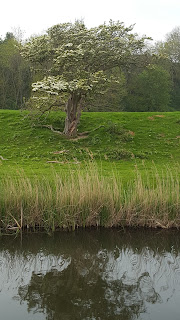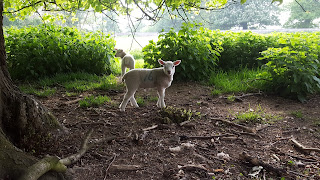The guard at Honor Oak Park wasn't exactly helpful when trying to sort out what ticket I needed to travel to Hastings but back from Winchelsea. I don't blame him. He's probably pissed off with his employers and given up hope. That's another thing that happens when services are run purely for profit. Staff become dissatisfied and, eventually, quit. Ask teachers. Ask doctors.
With all that in mind it's hardly a surprise that Adam, Teresa, and Shep decided to drive down. In Teresa's new electric car. It required two charges along the way and single lane traffic made them a bit late but that didn't impact on what turned out be yet another utterly wonderful, truly rewarding walk.
I met Pam in East Croydon station and we joined Kathy on the stopping service down to Hastings. It took us past the remains of Pevensey Castle and the pretty little resort of Cooden Beach before dropping us off in Hastings where we made our way, sharpish (the new town's not all that), to the Old Town. At the Café Royale on Castle Street we took late breakfast. I had cheese omelette'n'chips and Pam was very artistic in the way she squirted her ketchup over her veggie breakfast.
Sitting in the sun eating fry-ups on the English seaside (as Pam layered on her 'Baby in the Shade' factor 50 suntan lotion) we felt like we were on a proper old fashioned holiday. I resisted the temptation to don a knotted handkerchief on my head or buy a saucy postcard and instead, once Shep, Adam, and Teresa arrived, the six TADS walked along the front past a range of pubs with people enjoying early afternoon pints in the sunshine. It was tempting to go in and get rat arsed. It was tempting, too, to cross the road to play in the arcades or ride on the funfair but, instead, we stuck to the plan and carried on past Regency and Victorian buildings to the part of Hastings known as the Stade (old English for 'landing place').
There was a plaque for Dante Gabriel Rossetti and half-quaint, half-gloomy blackened clapboard fishing huts but more exciting still was our chance to ride Britain's steepest funicular railway. Who doesn't enjoy a funicular? The slight trepidation of being high up and exposed was countered by the beauty of the views and the way the golden sunlight lit up the tracks as we sped up Britain's steepest example (39 degrees) of this enthralling form of transportation. It certainly saved our legs too. We'd be needing them later.
Disembarking in Hastings Country Park we began our clifftop walk with a fairly sedate stretch that took in an Iron Age fort, a beacon, and some gently undulating grassland.
The walk gradually got hillier but the views and the beauty didn't let up one iota. We passed through Ecclesbourne Glen, Fairlight Glen, and Warren Glen and along the Fire Hills. The baked and cracked soil, the canopy of green, and the perfect blue skies gave the illusion we were somewhere far more tropical than East Sussex. A sign warned us of a closed path due to a recent landslide but as plenty of walkers were coming the other way we continued on. There's a nudist beach down from the cliff but we didn't see anyone on it. Perhaps we need to come again in August!?
Through gorse and bluebells we yomped until we met up with our friend Stuart, his wife Rachel and their three boys (Luke, Sam, and Jake). They live locally (St Leonards) and it was great to have them join us for a mile or two. Luke, the eldest of the boys, had already posted a fairly decent time in that morning's Park Run but neither him, nor his brothers, seemed remotely short of energy. A heartening sight when you read so much about childhood obesity. It was nearly as nice when I saw they'd installed a bench just so that I can sit down. Well, I'm not getting any younger. Or thinner it seems.
The village of Fairlight was our next destination. Amazing houses of all shapes and sizes. Modern architectural delights, textbook cottages, slightly shambolic affairs no doubt packed full of bric-a-brac. Such a different vibe to Hastings yet a highly appealing one. I felt pangs of jealousy towards those who could afford to live in such a place.
Fairlight sprawled out for further than one would imagine but, occasionally, through the branches of the trees, you're reminded you're still on the very edge of England looking out over the Channel. There was nobody swimming on the beach but there was a man urinating (or, the more dirty minded of TADS suggested, masturbating) up against a groyne. The houses in the next village of Cliff End were equally, if not more, impressive than in Fairlight.
Better still Cliff End had a pub. The bright blue Smuggler's offered this titanic wanker a pint of Titanic Anchor. They were playing some decidedly poor prog-rock and weren't allowed to give us their WiFi code (wtf?) but the pints went down well, the phones were charged, and Adam indulged in a pickled egg for the very reasonable sum of 60p.
The hills had pretty much come to an end and we entered a 'pancake-flat' stretch. Past old pill boxes and the Royal Military Canal built by William Pitt the Younger to deter a feared invasion from Napoleon. The invasion never happened but it's unclear how a 12ft canal would have deterred an army that had just crossed the channel. Either way it was a pretty stretch which led us on to the Pett Level where we were exposed to some mild, and not intolerable, wind.
There were sheep, cows, and a swan glid by as if off for a pint down The Smuggler's. Less attractively a baby lamb lay dead in the canal. At one point the Dimsdale Sewer (not as stinky as it sounds, honest) ran the other side of us and we were hemmed in my two separate water channels.
We turned off the canal and headed up a quiet road into Winchelsea, our final destination. Winchelsea is a tiny village now but was once a far bigger deal. Edward I employed a French architect to design the town along the lines of a bastide (fortified town) on a neat grid plan that stands 'til this day. Winchelsea became a vital link in the wine trade with Bordeaux and, when the River Brede was wide and flourishing, each merchant (fish, wool, cheese, and salt were also traded here) took advantage of the links to France and the good road into London.
The king imposed a perpetual rent on the town in return for the costs of building it and a sum of £14, a figure that has remained unchanged, is still collected annually. Winchelsea, along with nearby Rye (which we considered getting a ticket to so I could name this blog Ticket to Rye), was, due to its strategic significance, added to the list of Cinque Ports that already included Hastings, New Romney, Hythe, Sandwich, and Dover. Britain, at that time, had no navy and these ports were the first, only, line of defence against possible invasion. In exchange for providing ships and men for a certain number of days a year the ports were granted freedom from taxation and granted self-governance.
Smuggling prospered, however, and the town's wealth and location made it vulnerable to attack. In 1359 the French stormed Winchelsea and killed forty people whilst burning and looting the town. Similar invasions took place in 1360, 1380, and 1449 but it was natural forces, in the end, that brought to an end the golden era of Winchelsea. In the early 16c great masses of shingle caused the Brede to silt up and narrow and the town's days as a port were over.
You can get a sense of it's former majesty by walking through the New Gate (below). Once a medieval entrance to the town but now some distance from any sign of life - except some weary walkers. Looking back through the gate you can see the early 16c farmhouse of Wickham Manor, a sight that Shep claimed to be barely worth turning round for! The philistine!
As we closed in on Winchelsea itself I was taken aback by its beauty. I'd known next to nothing about the place yet the ruins, the trees, they all, in the late afternoon sun, seemed to have an almost surreal aesthetic about them. I thought about the art of Paul Nash and how sometimes, in his paintings, trees stood in for people.
Daniel Defoe and John Wesley (who once preached sermons against smuggling here) both compared the town to a skeleton and you can see why. You can also see why artists and authors like Ford Madox Ford, Henry James, William Makepeace Thackeray, Radclyffe Hall, and Joseph Conrad were so attracted to the place. Spike Milligan's even buried here in the graveyard of the huge and imposing Church of St Thomas the Martyr.
We watched the sun go down and turn the church first orange, then red, from the nearby New Inn. I had an Old Speckled Hen and a couple of East Coast IPAs, Pam tried a gin infused pint of pale ale, Kathy got busy with her regulation goldfish bowl of gin, and Adam, Teresa, and Shep (even Shep) had a latte. The barmaid could barely believe he'd placed the order and she doesn't even know him. I started to wonder if my thoughts were being passed directly to her larynx somehow.
The staff in The New Inn were mega-friendly. They didn't let us have the WiFi code because it was open to all. The music was a bit shit, one of those dreadful compilations of White Stripes and Radiohead songs reduced to tasteful, and offensively bland, acoustic covers, and the pub was a little quiet but it was, after a fairly stiff old walk, just the ticket. No curry (or Bangla) for a second walk in a row so Teresa and I had mac'n'cheese and the rest opted for falafel burgers. I finished up with a tasty mint choc chip'n'vanilla ice cream and we walked another kilometre along the dark unpaved road to Winchelsea's tiny train station that only had one platform.
Shep, Teresa, and Adam were heading back to Hastings where they'd booked a guest house. Pam, Kathy, and I took the train to Ashford International where I said goodbye to them before taking one more train to Victoria, another to Peckham Rye, and a bus home. It was nearly 1am and I'd been up for the best part of twenty hours but it'd all been worth it. I don't think I could ever get bored of celebrating good countryside, good food, good ale, and, most importantly of all, good friendships. Here's to the next one.






































































No comments:
Post a Comment